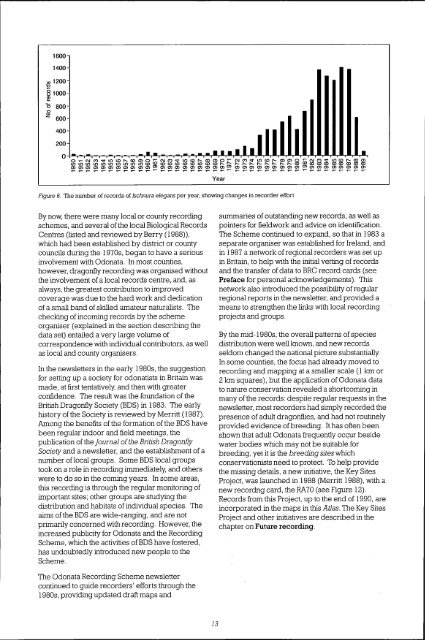Download - NERC Open Research Archive - Natural Environment ...
Download - NERC Open Research Archive - Natural Environment ...
Download - NERC Open Research Archive - Natural Environment ...
Create successful ePaper yourself
Turn your PDF publications into a flip-book with our unique Google optimized e-Paper software.
-<br />
co 1200<br />
8<br />
1600<br />
1400<br />
000<br />
15 800<br />
0<br />
600<br />
400<br />
200<br />
0 0 0.1<br />
LO LO LO<br />
0) 0) 0)<br />
LO<br />
111 14)<br />
0) 0)<br />
CD I,- CO 0) 0 ct tr) N- a) 0) 0 '" 01<br />
Lc) to to to co co co (0(o CD cD (0CD CD r, 1<br />
a) a) co co a) 0) (0(00)a) a) 0)0) a) a) 0) a)<br />
Figure 6. The number of records of lschnura elegans per year, showing changes in recorder effort<br />
By now, there were many local or county recording<br />
schemes, and several of the local Biological Records<br />
Centres (listed and reviewed by Berry (1988)),<br />
which had been established by district or county<br />
councils during the 1970s, began to have a serious<br />
involvement with Odonata. In most counties,<br />
however, dragonfly recording was organised without<br />
the involvement of a local records centre, and, as<br />
always, the greatest contribution to improved<br />
coverage was due to the hard work and dedication<br />
of a small band of skilled amateur naturalists. The<br />
checking of incoming records by the scheme<br />
organiser (explained in the section describing the<br />
data set) entailed a very large volume of<br />
correspondence with individual contributors, as well<br />
as local and county organisers.<br />
In the newsletters in the early 1980s, the suggestion<br />
for setting up a society for odonatists in Britain was<br />
made, at first tentatively, and then with greater<br />
confidence. The result was the foundation of the<br />
British Dragonfly Society (BDS) in 1983. The early<br />
history of the Society is reviewed by Merritt (1987).<br />
Among the benefits of the formation of the BDS have<br />
been regular indoor and field meetings, the<br />
publication of the Journal of the British Dragonfly<br />
Society and a newsletter, and the establishment of a<br />
number of local groups. Some BDS local groups<br />
took on a role in recording immediately, and others<br />
were to do so in the coming years. In some areas,<br />
this recording is through the regular monitoring of<br />
important sites; other groups are studying the<br />
distribution and habitats of individual species. The<br />
aims of the BDS are wide-ranging, and are not<br />
primarily concerned with recording. However, the<br />
increased publicity for Odonata and the Recording<br />
Scheme, which the activities of BDS have fostered,<br />
has undoubtedly introduced new people to the<br />
Scheme.<br />
The Odonata Recording Scheme newsletter<br />
continued to guide recorders' efforts through the<br />
1980s, providing updated draft maps and<br />
Year<br />
13<br />
Cct O<br />
I, - 1,-<br />
0) 0)<br />
LO CD r- 03 0) 0<br />
r- l- 03<br />
0) 0) 0) CD 0) 0)<br />
C1,1<br />
CO 03<br />
0,<br />
LO CD<br />
op a.)<br />
0)0)<br />
summaries of outstanding new records, as well as<br />
pointers for fieldwork and advice on identification.<br />
The Scheme continued to expand, so that in 1983 a<br />
separate organiser was established for Ireland, and<br />
in 1987 a network of regional recorders was set up<br />
in Britain, to help with the initial vetting of records<br />
and the transfer of data to BRC record cards (see<br />
Preface for personal acknowledgements). This<br />
network also introduced the possibility of regular<br />
regional reports in the newsletter, and provided a<br />
means to strengthen the links with local recording<br />
projects and groups.<br />
By the mid-1980s, the overall patterns of species<br />
distribution were well known, and new records<br />
seldom changed the national picture substantially.<br />
In some counties, the focus had already moved to<br />
recording and mapping at a smaller scale (1 km or<br />
2 km squares), but the application of Odonata data<br />
to nature conservation revealed a shortcoming in<br />
many of the records: despite regular requests in the<br />
newsletter, most recorders had simply recorded the<br />
presence of adult dragonflies, and had not routinely<br />
provided evidence of breeding. It has often been<br />
shown that adult Odonata frequently occur beside<br />
water bodies which may not be suitable for<br />
breeding, yet it is the breeding sites which<br />
conservationists need to protect. To help provide<br />
the missing details, a new initiative, the Key Sites<br />
Project, was launched in 1988 (Merritt 1988), with a<br />
new recordng card, the RA70 (see Figure 12).<br />
Records from this Project, up to the end of 1990, are<br />
incorporated in the maps in this Atlas. The Key Sites<br />
Project and other initiatives are described in the<br />
chapter on Future recording.

















